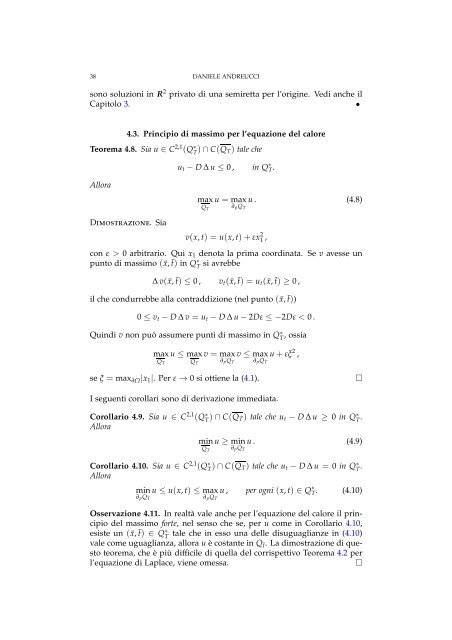Appunti per il corso di Fisica Matematica Daniele Andreucci ...
Appunti per il corso di Fisica Matematica Daniele Andreucci ...
Appunti per il corso di Fisica Matematica Daniele Andreucci ...
You also want an ePaper? Increase the reach of your titles
YUMPU automatically turns print PDFs into web optimized ePapers that Google loves.
38 DANIELE ANDREUCCIsono soluzioni in R 2 privato <strong>di</strong> una semiretta <strong>per</strong> l’origine. Ve<strong>di</strong> anche <strong>il</strong>Capitolo 3.•4.3. Principio <strong>di</strong> massimo <strong>per</strong> l’equazione del caloreTeorema 4.8. Sia u ∈ C 2,1 (Q ∗ T )∩C(Q T) tale cheu t −D ∆u ≤ 0, in Q ∗ T .AlloraDimostrazione. SiamaxQ Tu = max∂ p Q Tu. (4.8)v(x,t) = u(x,t)+εx 2 1 ,con ε > 0 arbitrario. Qui x 1 denota la prima coor<strong>di</strong>nata. Se v avesse unpunto <strong>di</strong> massimo (¯x,¯t) in Q ∗ Tsi avrebbe∆v(¯x,¯t) ≤ 0, v t (¯x,¯t) = u t (¯x,¯t) ≥ 0,<strong>il</strong> che condurrebbe alla contrad<strong>di</strong>zione (nel punto (¯x,¯t))0 ≤ v t −D ∆v = u t −D ∆u−2Dε ≤ −2Dε < 0.Quin<strong>di</strong> v non può assumere punti <strong>di</strong> massimo in Q ∗ T , ossiamaxQ Tu ≤ maxQ Tv = max∂ p Q Tv ≤ max∂ p Q Tu+εξ 2 ,se ξ = max ∂Ω |x 1 |. Per ε → 0 si ottiene la (4.1).□I seguenti corollari sono <strong>di</strong> derivazione imme<strong>di</strong>ata.Corollario 4.9. Sia u ∈ C 2,1 (Q ∗ T )∩C(Q T) tale che u t − D ∆u ≥ 0 in Q ∗ T .AlloraminQ Tu ≥ min∂ p Q Tu. (4.9)Corollario 4.10. Sia u ∈ C 2,1 (Q ∗ T )∩C(Q T) tale che u t − D ∆u = 0 in Q ∗ T .Alloramin∂ p Q Tu ≤ u(x,t) ≤ max∂ p Q Tu, <strong>per</strong> ogni (x,t) ∈ Q ∗ T . (4.10)Osservazione 4.11. In realtà vale anche <strong>per</strong> l’equazione del calore <strong>il</strong> principiodel massimo forte, nel senso che se, <strong>per</strong> u come in Corollario 4.10,esiste un (¯x,¯t) ∈ Q ∗ Ttale che in esso una delle <strong>di</strong>suguaglianze in (4.10)vale come uguaglianza, allora u è costantein Q¯t. La<strong>di</strong>mostrazione <strong>di</strong>questoteorema, che è più <strong>di</strong>ffic<strong>il</strong>e <strong>di</strong> quella del corrispettivo Teorema 4.2 <strong>per</strong>l’equazione <strong>di</strong> Laplace, viene omessa.□
















